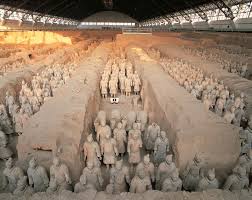
Where is the Tomb of Qin Shi Huang?
Location and History
Located at the northern foot of Lishan Mountain, 35 kilometers northeast of Xi'an, Shaanxi Province, Qinshihuang Mausoleum is the tomb of Emperor Qinshihuang, founder of the first unified empire in Chinese history during the 3rd century BCE.
- Lishan Mountain: This mountain holds significant cultural and historical importance in China. It's known for its scenic beauty and has been a popular subject in Chinese art and literature for centuries. The presence of the mausoleum further adds to its historical significance.
- Xi'an: As the ancient capital of thirteen dynasties, Xi'an boasts a rich tapestry of history and culture. The proximity of Qin Shi Huang's Mausoleum to this historical hub highlights its importance in the grand narrative of China's past.
- Emperor Qinshihuang: Known for unifying China after centuries of warring states, Emperor Qinshihuang (259-210 BCE) is a pivotal figure. He standardized weights and measures, currency, and even the written script, laying the foundation for a unified Chinese identity. His tomb, therefore, is not just a burial ground; it's a monument to the birth of a unified China.
The Scale and Grandeur
The mausoleum complex is colossal, covering an area of approximately 56 square kilometers (21.6 square miles). To put this into perspective, it's roughly 80 times the size of the Forbidden City in Beijing!
This vast complex is divided into two major parts:
- The Inner City: Encompassing the burial mound itself, this area remains largely unexcavated. Historical records suggest it houses the emperor's tomb chamber, along with treasures and artifacts reflecting his status and the era. The mysteries contained within the Inner City continue to fascinate archaeologists and historians.
- The Outer City: This area features various pits housing the famous Terracotta Army, along with the tombs of concubines, and other structures that provide insights into the social structure and practices of the Qin Dynasty.
The Terracotta Army
The most famous feature of Qinshihuang's Mausoleum is undoubtedly the Terracotta Army, discovered in 1974 by local farmers. This army of life-sized terracotta figures, each with unique features, was meant to protect the emperor in the afterlife.
- Life-Sized and Unique: Standing in battle formation, the soldiers, archers, and chariots showcase the advanced craftsmanship of the time. The meticulous attention to detail on each figure - from their hairstyles to the armor - offers a glimpse into the military might and artistry of the Qin dynasty.
- A Window into the Past: The Terracotta Army is not merely a collection of statues; it is a time capsule. Their attire, weapons, and formations provide valuable insights into ancient Chinese military tactics and technology.
Ongoing Excavations and Research
Excavations and research at Qinshihuang's Mausoleum are ongoing, with new discoveries constantly adding to our understanding of this significant historical site. While the main tomb chamber remains unopened due to preservation concerns and respect for the emperor, the ongoing work continues to unveil the secrets of this ancient wonder.
Q&A
- Q: When was the Terracotta Army discovered? A: The Terracotta Army was discovered in 1974 by local farmers digging a well.
- Q: Why hasn't the main tomb of Qin Shi Huang been opened? A: The main tomb remains unopened due to concerns about preserving the artifacts inside and out of respect for the emperor.
- Q: How long did it take to build Qin Shi Huang's Mausoleum? A: Construction of the mausoleum began when Qin Shi Huang ascended the throne at age 13 and continued for decades, involving over 700,000 laborers.